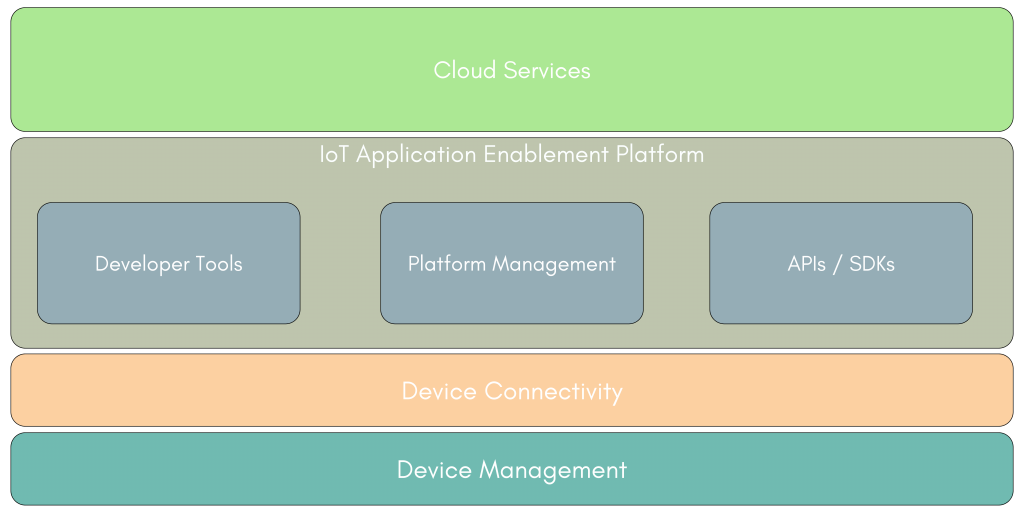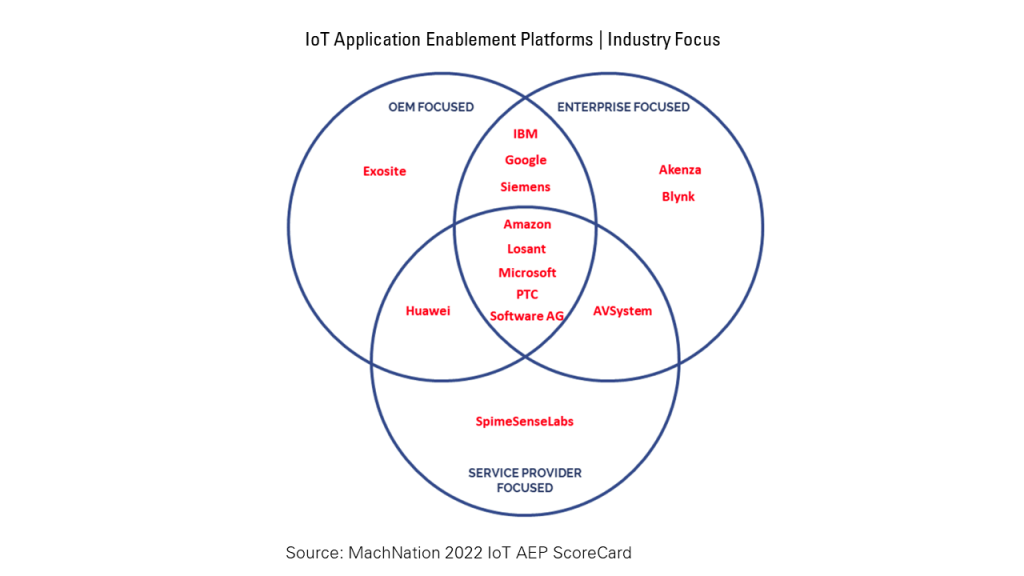The IoT application enablement platform (AEP) space has continued to grow into one of the most critical technology sectors of the Internet of Things (IoT). Enterprises realise that (1) a well-built IoT AEP saves significant development time and money in the creation and operation of an IoT solution and (2) an exceptional AEP architecture aids in the reliability and scalability of an end-to-end IoT solution.
According to MachNation definitions, an IoT AEP is a technology-centric offering optimised to deliver an industry-agnostic, extensible middleware core for building a set of interconnected or independent IoT solutions for customers, says Josh Taubenheim, IoT technology analyst at MachNation. To be successful, an AEP vendor relies on a flexible deployment model; a comprehensive set of device and enterprise-backend connector SDKs and APIs; and a set of well-documented developer resources. AEP vendors assemble a network of application development, system integrator, and service provider partners that build custom IoT applications on the platform for customers.
The following graphic is a simplified representation of where an IoT AEP platform typically sits within an enterprise IoT architecture:

We spend a lot of time helping enterprise buyers define their IoT strategy and evaluate AEPs to serve as the core of their solution. After all, there are dozens if not hundreds of available IoT solutions on the market today that have core competencies that vary widely. Why pick an AEP platform to serve as the central-nervous-system of your software architecture? While specific technology requirements and business value are certainly at the centre of any critical evaluation, enterprises that are considering implementing an IoT AEP solution, as opposed to other IoT solutions that offer a more narrow scope of capabilities (DM-specific, mobile-specific, edge-specific, etc.) are concerned that:
- Their capital expenditures on implementing new systems will yield a return on investment
- They pick a solution that is highly flexible and has the ability to evolve with changing business priorities
- They select a solution provider that gives them access to a valuable ecosystem of technology and business partners
With that in mind, let’s take a look at how MachNation evaluates IoT AEP vendors and their technology.
MachNation’s evaluation of IoT AEP vendors
For the eighth year, MachNation has published its IoT Application Enablement ScoreCard to aid enterprise, system integrator (SI), and service provider (SP) buyers in their research processes and to provide guidelines for the most important AEP characteristics. We have conducted these analyses due to enterprises’ strong interest in having successful, rapid, well-designed, and scalable IoT solution implementations.

MachNation’s 2022 IoT Application Enablement ScoreCard rates vendors against the requirements of services to enable enterprises’ IoT deployments. Interestingly, MachNation has found a renewed interest in IoT AEPs and the viability of cloud-based IoT services. This is possibly spurred by the current global pandemic and recognition that creating IoT solutions that meet enterprises’ business continuity requirements for high reliability and high performance is vitally important. A “good enough” IoT AEP simply will not suffice in today’s changed world.
MachNation rated 14 IoT AEP vendors across a set of requirements spanning four categories. The four categories of requirements consist of 15 sub-requirements that are the underlying bases of MachNation’s rating. The four categories are:
Develop
MachNation believes that a top IoT application enablement vendor’s technology should be built with the IoT developer in mind. While the requirement for customer-side development effort should be minimised, almost all AEP deployments will require use case-specific developer investment to deploy. Thus, the better a platform caters to developers and typical developer workflows, the better it enables fast and efficient platform implementation. When evaluating the extent of a developer-focused approach, there are four things MachNation evaluates: a cogent platform architecture; well-documented and fully featured platform APIs and device SDKs; an effective and modular application development framework; and a scalable and extensible data management framework.
Deploy
MachNation believes that an IoT platform must provide an effective deployment solution for customers. This gives customers the ability to choose the type of deployment that best suits their business and technology needs, while ensuring that platform capabilities do not impose unwarranted deployment costs on customers. When evaluating the deployment capabilities of a platform, there are four things MachNation evaluates: deployment flexibility, deployment ease, edge and fog capabilities, and scalability.
Operate
IoT AEP vendors should build their platforms to provide users with operational sophistication. Operational sophistication is created when vendors focus on providing excellence in 4 key subcategories: platform management; device management; monitoring; and a unified and refined product. The platform should have a set of features that empower an operations technology (OT) user to effectively manage an IoT deployment.
Extend
Best-positioned IoT AEP vendors will have a well-developed ecosystem, appropriately-sized business, and a sound IoT vision. The best IoT AEP vendors should provide a rich platform ecosystem of hardware and software partners. Due to lack of expertise with IoT solutions, public and private sector organisations rely on these partnership networks to efficiently implement IoT solutions using industry best-practices. All other things being equal, a vendor with more business resources will be more successful in selling to enterprise customers. MachNation evaluates a vendor’s ability to extend and grow its business in 3 key areas: platform ecosystem, company size, and vision.
A best-in-class IoT AEP platform vendor excels in each of MachNation’s four evaluation categories with particular emphasis on providing exceptional technology, a refined user experience (UX), and strong documentation.
MachNation’s 2022 IoT Application Enablement ScoreCard includes the following vendors (listed alphabetically): Amazon, Akenza, AVSystem, Blynk, Exosite, Google, Huawei, IBM, Losant, Microsoft, PTC, Siemens, Software AG, and SpimeSenseLabs. MachNation selected a group of participating vendors that adequately represent the diversity of approaches and sizes in this burgeoning IoT AEP market. No vendors were charged a fee to participate.
Conclusion
There is no one-size-fits-all AEP solution. There are many determining factors enterprises need to consider when evaluating IoT AEP vendors, both present and future. For an enterprise to be successful, an IoT AEP implementation should:
- Empower its developers and OT users
- Be flexible, extensible, and provide the tools needed to evolve over time
- Act as a central management platform for connected systems
- Have an open and well-supported ecosystem of partners and developers
The author is Josh Taubenheim, IoT technology analyst at MachNation.
Comment on this article below or via Twitter: @IoTNow_OR @jcIoTnow










